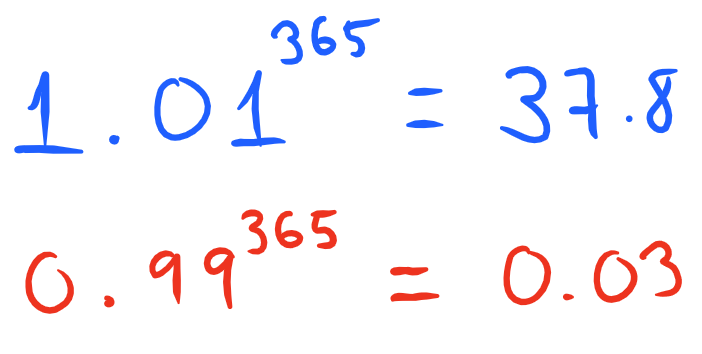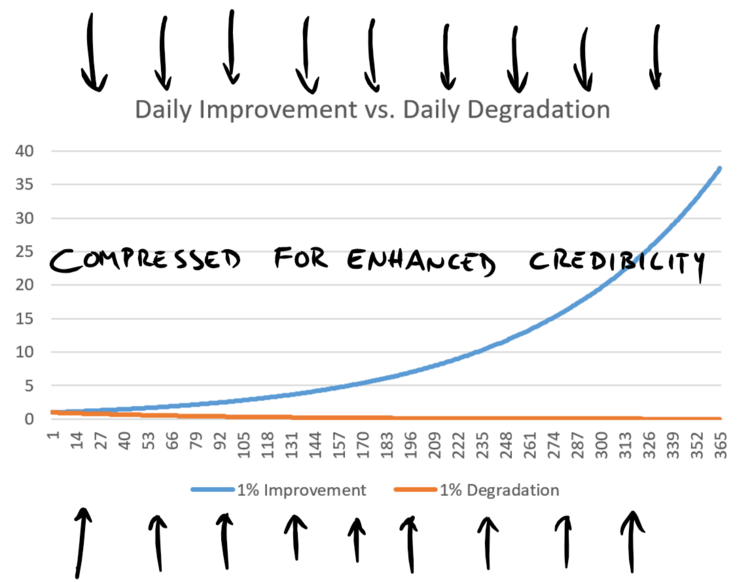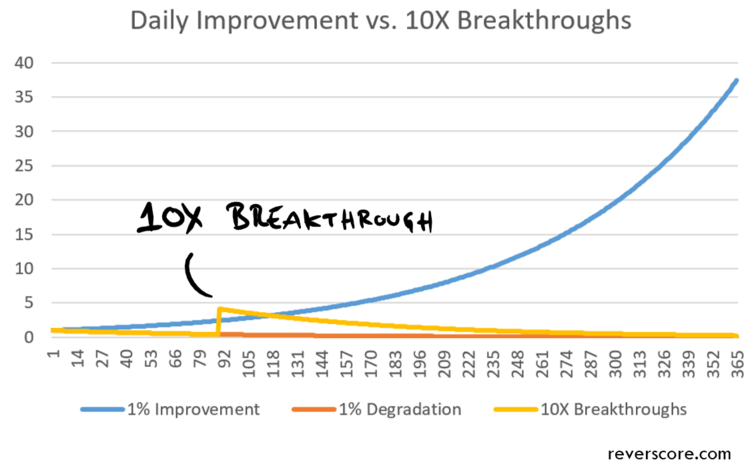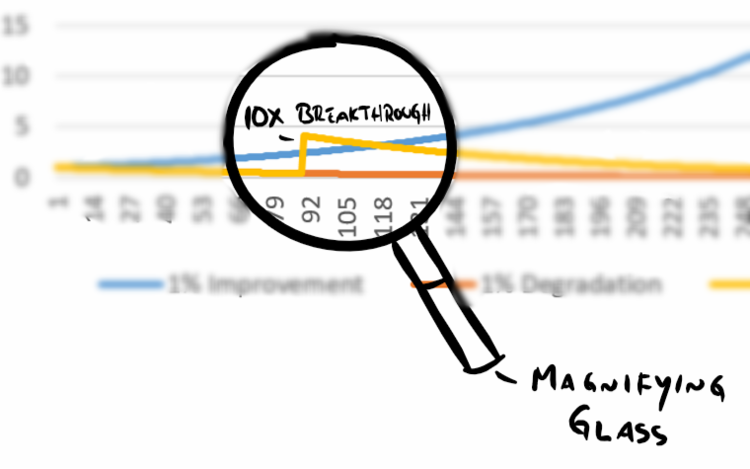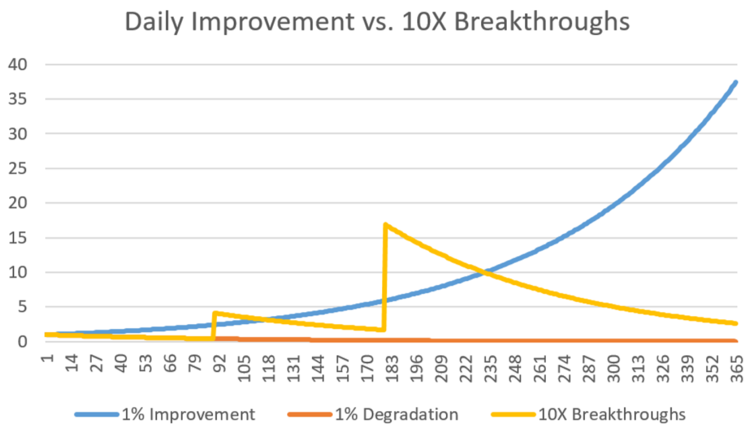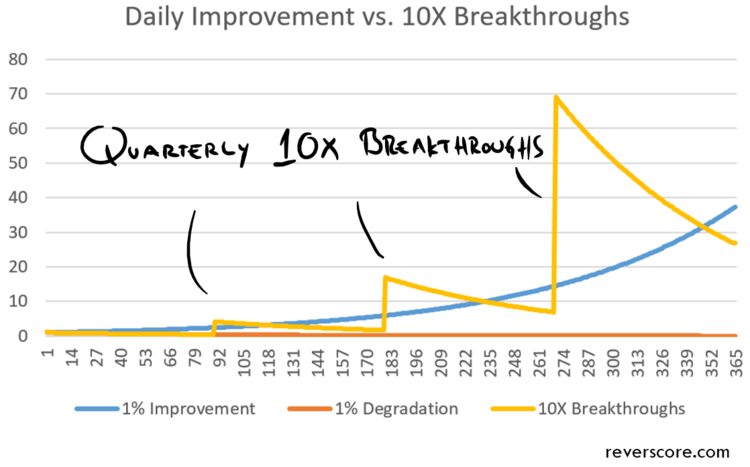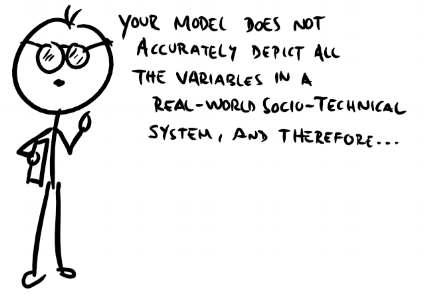Why Breakthrough Innovation is overrated (and what you should do instead)
3 minutes, 9 seconds read

A few weeks ago, I was walking through the office space of a Silicon Valley accelerator, and I saw a printed sheet of paper with the geekiest defense of continuous improvement. It was stated like this:
What it means is: if you start with 1, and you improve 1% every day for a full year, you end up with 37.8; and if you degrade 1% every day, you end up with 0.03.
That’s an enormous difference! It’s a great wake-up call to the radical benefits of Kaizen: the non-stop improvement philosophy that flourished in post-WWII Japan. We all realize daily improvement is good, but not that good.
For the sake of those of us who are more visual than formulaic, I graphed the equation:
That 1% exponential curve looks stunning, and I can imagine what you’re thinking:
“That hand-made graph is surely doctored to appear steeper than it should.” I understand the skepticism: our mind can’t properly grasp exponential progress.
If it makes you feel better, here’s the same graph done with Excel:
Better now?
Good. Now, for space-saving and credibility-enhancement purposes I will compress that graph even more:
It’s a shame that continuous improvement gets belittled; companies would rather wait for the home-run idea that will deliver a 10X breakthrough that solves everything. The argument goes: why settle for a 1% daily improvement when we could get 1,000% from a big innovation?
The thing few companies realize (because so few have achieved it) is that 10X improvement is not what it’s cracked up to be.
Let’s imagine your rockstar organization can attain such a radical result in only three months, if they put their minds to it. What would that look like? It turns out, not much:
Did you see that?
While a breakthrough improvement sounds very promising, it pales versus the results of compounded daily gains.
But, let’s give radical innovation a chance. What if you could pull the 1000% performance improvement trick twice in a year?
Still, not much in the end, right? That 1%-degradation is a real sucker. Now, let’s assume your company can achieve the unachievable: a 10X improvement in performance each quarter. It would look like this:
A geek might argue that, on day 365+1, another breakthrough innovation is due. A more realistic geek might argue that a mathematical formula is no way to reflect the improvement efforts of a real organization
Exactly. It’s a fantasy to believe that constant breakthrough innovation would stem from a company that neglects daily improvement and all its accompanying healthy habits: curiosity, problem-solving, persistence, challenging the status quo, a bias for action, speed, agility, enthusiasm, and engagement.
Kaizen prepares the ground so that the seeds of radical innovation can flourish. The two approaches are not opposed; in fact, they exponentiate each other:
Exponential results are not merely a hypothetical possibility; they are a reality in organizations that make incremental improvements a daily habit.
Kaizen is the reason why Toyota is currently worth more than GM, Ford, and Honda combined; and that it has enough cash to acquire its two largest competitors from Detroit.
Thanks to 1% improvements, the British Cycling team went from a single gold in 76 years, to hoarding all the medals in the last three summer Olympics. The mantra according to the team’s coach, Sir Dave Brailsford, is this: “Forget about perfection; focus on progression, and compound the improvements.”
In logic and reality: when you promote Frontline Innovation through continuous improvement and breakthrough projects, you will be unstoppable.
Now, it’s time to ask yourself (and your team) the question: what will you improve by 1% today?
Like this content? Sign up for our Newsletter
[hubspot type=form portal=561211 id=fda6d445-739e-4072-8dae-68b94971a266]THE FRONTLINE DOJO
More Articles
How to develop the next billion Knowledge Workers
3 minutes, 51 seconds read
Digital transformation in manufacturing is not what you think it is
10 minutes, 36 seconds read
The human side of change management: lessons learned from Toyota, Airbus, and Silicon Valley
1 minute, 28 seconds read
The true meaning of Genchi Genbutsu
3 minutes, 5 seconds read
